Saturday, October 6. 2007
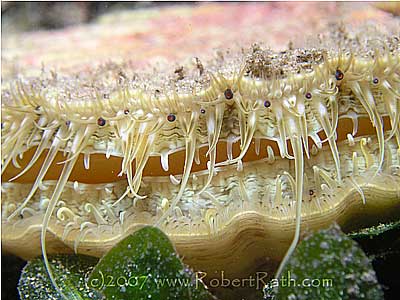 This stunning looking creature is also the prize of many great seafood chefs. The King Scallop, Pecten fumatus is highly prized by the commercial fishery industry in Southern Australia.
Also known as the Southern Scallop, the Tasmanian Scallop or the Commercial Scallop, they can grow to over 14 cm across and live for just as many years. Scallops are filter feeders, living on plankton and other organic debris and are common to all our coastal waters.
This photo was taken on a night dive during my last Open Water course over in Edithburgh. It's fun to leave the students on the jetty, then come back to them with photos of what they'll soon be experiencing for themselves.
Until the next post, take care out there and keep diving ( if that's what you do! ) ...Robert  Photo: Robert Rath C5060 1/30s at f/8 ISO200 30mm, Lens UWL100-28AD, Inon D2000 Strobe
Photo: Robert Rath C5060 1/30s at f/8 ISO200 30mm, Lens UWL100-28AD, Inon D2000 Strobe
Tuesday, October 2. 2007
 This weekend's get-away took us to the Flinders Ranges in South Australia's mid-north.
How lovely it was to sit by an open camp fire, stare into the heavens and not have to worry about getting into a cold, damp wetsuit.
In all of the beauty this place has to offer, there is nothing like the feelings invoked by a starry night in the outback.
I hope this image gives a sense of the sky we never get to see in our suburban world.
Until the next post, take care out there and keep staring into the heavens ( if that's what you do! ) ...Robert  Photo: Robert Rath EOS40D 160s at f/8 ISO1600 10mm
Photo: Robert Rath EOS40D 160s at f/8 ISO1600 10mm
Sunday, September 23. 2007
 I just love this sleepy little town with its world-famous jetty. Many times though, I find myself teaching a group of new divers when that magic photo opportunity literally swims on by...
It was near the end of their fourth open water dive. I was leading the way back under the jetty while Alexius took care of the rear. In the distance, just out of vision there appeared a very large shadow which was not in a place I expected one to be. I realised it was moving and it was very, very large. A moment of fear, then a moment of excitement as the shadow turned back towards us.
Out of the gloom swam the most magnificent, majestic and certainly the largest stingray I have seen in nearly 18 years of diving. At around 2m in span and over 4m in length this Smooth Stingray, Dasyatis brevicaudata, glided through the pylons with both precision and grace. I turned and swam alongside for a few moments before leaving it to glide out into the sunlit water and disappear into the distance.
This was a magical experience that I may not have appreciated as much if I had been staring into the viewfinder of my camera. After the dive, it was wonderful to share the experience with my students, some of whom much to their chagrin had been looking elsewhere for the entire encounter.
Today was a wonderful reminder of why we go to all that effort to put ourselves under the waves: to bring back treasured memories like these.
Until the next post, take care out there and keep diving ( if that's what you do! ) ...Robert  Photo: Robert Rath EOS40D 1/250s at f/11 ISO400 10mm
Photo: Robert Rath EOS40D 1/250s at f/11 ISO400 10mm
Saturday, September 1. 2007
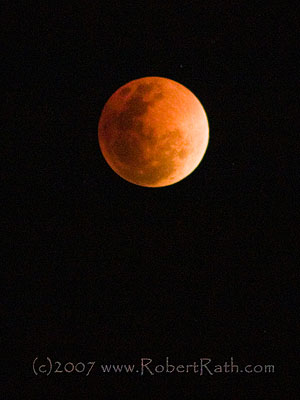 August 28, 2007 and we were treated to a most wonderful evening show. For around 45 minutes, the moon became red as it passed through the Earth's shadow.
This photograph was taken from my back lawn in competition with Adelaide's night sky.
Total lunar eclipses come in groups; usually we can observe two or three during a period of a year or so followed by a few years without any.
Lunar eclipses are visible from the entire night-time hemisphere of our planet. Because of this they are more frequently observed and seem to be numerous. They are, however, three to five times less frequent than their spectacular solar eclipse counterpart.
Until the next post, take care out there and keep staring into the heavens ( if that's what you do! ) ...Robert  Photo: Robert Rath EOS300D 1.6s at f/5.6 ISO1600 300mm
Photo: Robert Rath EOS300D 1.6s at f/5.6 ISO1600 300mm
Saturday, August 18. 2007
 The Potato Cod, Epinephelus tukula, is one of the largest members of the groper family. Cod Hole, out on the Northern Great Barrier Reef, is renowned for its family of curious Potato Cod who make this a special location for all who visit.
This was our last dive of the trip and we were not disappointed. It was a beautiful, picture-perfect dive. Big cod, sharks, rays and the most amazing coral gardens. We lingered here for as long as we dared as the current became stronger and stronger. Finally we decided it was time to return to the boat.
As all divers are taught we had done the right thing and dived up-current during the dive. By the time we decided to end the dive the current was so strong we could no longer make any headway anyway.
The swim back to the boat took only a couple of minutes and as we neared I could tell we only had one shot. Racing in at 6m, we caught the first shot line on the port side of the boat. The current was so strong now it started dragging us to the surface. Still hanging on to the port shot line at 3m we grabbed the starboard line of the deco-bar and there Jennifer and I stayed locked together flapping wildly in the current. A minute later we had worked our way up to the starboard ladder and back on board. Hearts racing, adrenalin pumping - but smug at the fact that we did not have to be chased all over the ocean by the tenders like some of the other divers - we said our farewells to the Potato Cod of the Cod Hole!
Until the next post, take care out there and keep diving ( if that's what you do! ) ...Robert  Photo: Robert Rath C5060 1/30s at f/6.7 ISO200 Inon UWL100-28AD Lens and D2000 Strobe
Photo: Robert Rath C5060 1/30s at f/6.7 ISO200 Inon UWL100-28AD Lens and D2000 Strobe
Thursday, August 2. 2007
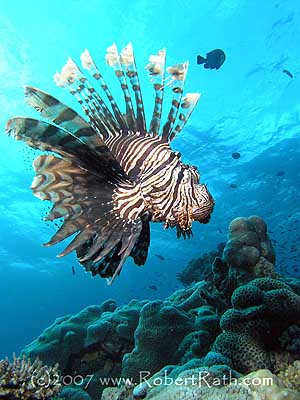 This Lionfish or Red Firefish, Pterois volitans, was a real poser circling the top of the Pinnacle. Yes, another cliché photo but one begging to be taken!
As mentioned in a previous post, Lionfish are common to the Indo-Pacific region and considered every bit a part of our tropical waters. Its new arrival in the U.S.A. however is not welcome at all since being introduced by the aquarium trade back in 1992. Having no natural predators in other parts of the world means this beautiful creature has become an introduced pest to our friends bordering the Atlantic Ocean.
Until the next post, take care out there and keep diving ( if that's what you do! ) ...Robert  Photo: Robert Rath C5060 1/125s at f/5.6 ISO200 Inon UWL100-28AD Lens and D2000 Strobe
Photo: Robert Rath C5060 1/125s at f/5.6 ISO200 Inon UWL100-28AD Lens and D2000 Strobe
Sunday, July 22. 2007
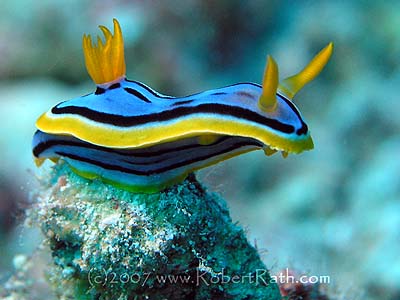 This beautiful nudibranch, Chromodoris elisabethina, or possibly , Chromodoris annae, was one of several different species we found at Pixie Pinnacle during our Minke trip.
The distinctive broken black stripe down the back is usually associated with ... elisabethina. See my previous entry for Chromodoris annae which clearly has no black markings. Please let me know your thoughts on the identification.
Pixie Pinnacle is an amazing site near Ribbon Reef #10. The pinnacle itself presents an amazing array of life and will often be the most attractive part of the dive. It is worthwhile though exploring the scree and rubble at the pinnacle's first base where we found a diverse world of small critters including Nudibranchs and Mantis Shrimps.
This little guy was down in the scree and rubble at 20m and reminded me of PNG "Muck Diving".
Until the next post, take care out there and keep diving ( if that's what you do! ) ...Robert  Photo: Robert Rath C5060 1/90s at f/4.8 ISO200 Inon UCL165AD Macro Lens and D2000 Strobe
Photo: Robert Rath C5060 1/90s at f/4.8 ISO200 Inon UCL165AD Macro Lens and D2000 Strobe
Monday, July 16. 2007
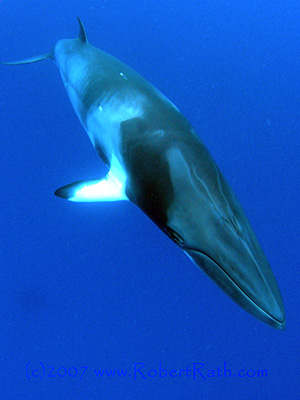 We have just returned from an absolutely wonderful trip to the Ribbon Reefs on the Great Barrier Reef. Three days of diving with Minke whales, reef fish, pelagics, sea turtles and even the odd diver have left us longing for the warm seas again now that we are back in Adelaide.
This one particular Minke swam straight towards me on several occasions, each time coming a little closer before bearing away. It was a magical experience, and at times I felt I almost wasted it being behind a camera!
Minke whales, Balaenoptera acutorostrata, visit the Ribbon Reefs every year during June and early July on their yearly migration. They are beautiful, inquisitive animals and actually seek out encounters with snorkellers and divers alike.
We dived from Mike Ball's Spoilsport and were impressed with their Minke education program as well as their adherence to a strict protocol used for Minke encounters.
For more information about Minke whales please visit http://www.minkewhaleproject.org/
Until the next post, take care out there and keep diving ( if that's what you do! ) ...Robert  Photo: Robert Rath C5060 1/90s at f/4.0 ISO200 Lens UWL100-28AD
Photo: Robert Rath C5060 1/90s at f/4.0 ISO200 Lens UWL100-28AD
Monday, July 9. 2007
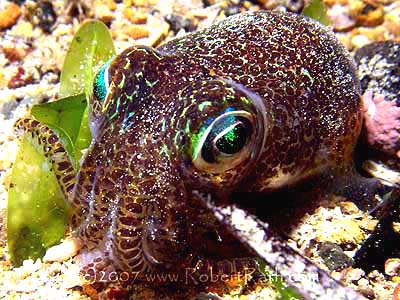 I can't believe it has been nearly a month since my last post! This last weekend we were in Edithburgh again with a group of nine Open Water students. Even with 11 degrees, wetsuits and less than 2m visibility, they were a fantastic and enthusiastic group. Well done!
Despite the teaching, the cold and poor visibility, we still managed a few "fun" dives and captured some lovely images. The photo for this post is a very awesomely cute Southern Dumpling Squid, Euprymna tasmanicas.
The amazing thing about the Southern Dumpling squid is that it produces light from an organ in its gill cavity. This organ contains bacteria that glow in the dark, and the dumpling squid uses this light to hide its silhouette from below by exactly matching the light from above. Very impressive camouflage technology!
On Sunday afternoon, my old mate David Bryant from Seapics http://www.seapics.com.au/ joined us for a dusk dive after having driven non-stop from Melbourne that morning.
David and some of his friends have come over to dive with the Whyalla cuttlefish, so it was a great chance to catch up and dive together again after some 12 or more years.
Until the next post, take care out there, keep diving ( if that's what you do! ) ...Robert  Photo: Robert Rath C5060 1/45s at f/8 ISO200 Lens UCL165AD Macro, Inon D2000 Strobe
Photo: Robert Rath C5060 1/45s at f/8 ISO200 Lens UCL165AD Macro, Inon D2000 Strobe
Saturday, June 9. 2007
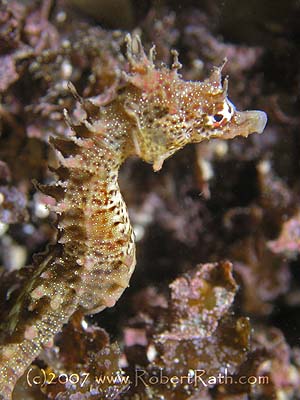 Night dives under Edithburgh jetty mean seahorses. Lots and lots of them! Almost all of them will be the Short-Head Seahorse, Hippocampus breviceps. No matter how patient I was, this little one would not look at me, so this is the best of a batch where turning away means 'you can't see me'.
Two wonderful days of diving here have left me with quite a collection of new photos, so stay tuned for more.
Until the next post, take care out there and keep diving ( if that's what you do! ) ...Robert  Photo: Robert Rath C5060 1/90s at f/4.8 ISO100 Lens UWL100-28AD, Inon D2000 Strobe
Photo: Robert Rath C5060 1/90s at f/4.8 ISO100 Lens UWL100-28AD, Inon D2000 Strobe
Sunday, June 3. 2007
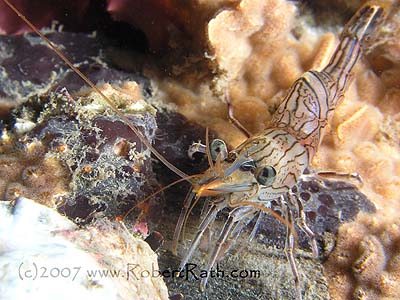 This little guy from tonight's night dive was a real treat to play with. I believe it is Rhynchocinetes australis but it could also be Rhynchocinetes kuiteri, so please drop me a note if you know for sure. For other underwater adventurers, calling it a shrimp will do nicely. 
The water is getting colder, but that simply means fewer people in the water and less silt in front of the lens. As much as I love taking people diving, there is nothing like having a little bit of space when wielding a camera.
A night dive is always a great way to prove to all the 'sensible' onlookers that the world is full of people doing crazy things. So, who'd actually want to be an onlooker on a beautiful calm moonlit Edithburgh night? Yes I agree too, the world is full of people doing crazy things! 
Until the next post, take care out there, keep diving ( if that's what you do! ) ...Robert  Photo: Robert Rath C5060 1/60s at f/8 ISO100 Lens UWL100-28AD, Inon D2000 Strobe
Photo: Robert Rath C5060 1/60s at f/8 ISO100 Lens UWL100-28AD, Inon D2000 Strobe
Sunday, May 20. 2007
 Every once in a while someone very special comes along who reminds us how wonderful our world is and how dreams really do come true when you desire and believe. Little 13-year-old Rachael from California is someone who came into my world and did just that.
When she was 12, Rachael first met a Leafy Seadragon at the Monterey Bay Aquarium. A couple of months later they were gone and that day Rachael made a decision to learn to dive so she could see them for herself where they live here in Southern Australia. Rachael had already overcome quite a few obstacles in her life and she took on this new adventure with 100% conviction.
In January, Rachael certified as a Junior Open Water Diver. Last week, Jennifer and I took her for her long-awaited dive with the "Dragons". It was a wonderful experience getting to meet Rachael and her mum Susie. The weather stayed calm and the visibility was not too bad at around 3-4m. In all Rachael saw between four and five Dragons on her epic dive - but nothing will ever top the look in Rachael's eyes when that very first Leafy Seadragon came into view.
Until the next post, take care out there, keep diving ( if that's what you do! ) and remember that dreams REALLY DO come true ...Robert  Photo: Robert Rath C5060 1/90s at f/2.8 ISO100 Lens UWL100-28AD, Inon D2000 Strobe and Natural Light
Photo: Robert Rath C5060 1/90s at f/2.8 ISO100 Lens UWL100-28AD, Inon D2000 Strobe and Natural Light
Saturday, May 12. 2007
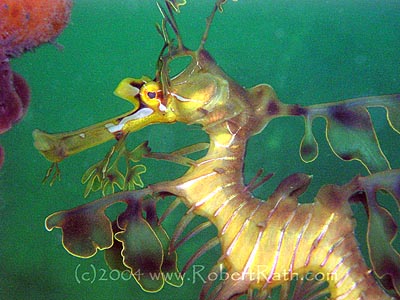 This week's photo is relic from the archives, my very first photograph of a Leafy Seadragon, Phycodurus eques.
I was just starting out with digital underwater photography and keen to hone my skills using a 3.2 megapixel auto snapshot camera I paid $200 for. I used this little camera solidly for 18 months taking thousands of photographs. In that time I learned so much about that little camera and how to squeeze every last ounce of performance from it.
I still use this camera from time to time, especially when snorkelling. Well actually it's not the same camera as the original one met an untimely demise off the coast of Kangaroo Island but that's a story for another time!
Until the next post, take care out there and keep diving ( if that's what you do! ) ...Robert  Photo: Robert Rath Olympus C350 1/100s at f/14 ISO400 Internal Flash
Photo: Robert Rath Olympus C350 1/100s at f/14 ISO400 Internal Flash
Wednesday, May 9. 2007
 Ok, nothing to do with diving but something to make your life more enjoyable all the same.
Don't you just detest the way this pesky little message keeps re-appearing every 10 minutes after you do a Microsoft Update! Has it every been the cause of accidentally trashing all your open work? Here's how to change it to remind you once per day so you can keep working and keep your sanity.
Start / Run / gpedit.msc / Local Computer Policy / Computer Configuration / Administrative Templates / Windows Components / Windows Update / Re-prompt for restart with scheduled installations (if you need more detail than this you probably should not attempt it)
You can configure how often it will nag you, or completely disable it. Now for the bad news... This does not work for Windows XP Home Edition and you will need to restart your computer ( or restart the Automatic Update Service for the techies ) for the new setting to take effect.
Until the next post, take care out there and keep updating your computer ( if that's what you do! ) ...Robert 
Sunday, May 6. 2007
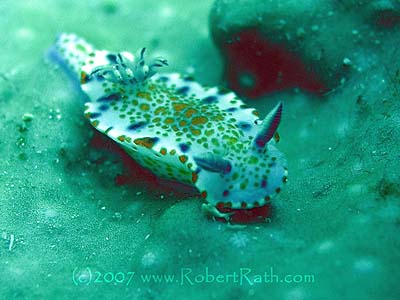 Well it seems that unless you can eat it no one bothers to give anything a common name so Ceratosoma amoena will have to do.
This shot is a classic example of having the wrong gear and making the best of it. All set up for wide angle, I came across this wonderful little guy no more that 15mm long. Removing the wide lens did not help as I simply could not get close enough.
Ok, time to compromise. Super-macro mode on the C5060 shuts down the flash system but at least allows me to get close enough. So now I am close enough but it is 20m down with no source of light! Using my largest aperture and the slowest shutter speed I could manage resulted in this 'not too bad' shot. Just imagine what the colours must have really been like. Oh, well... next time 
Until the next post, take care out there and keep diving ( if that's what you do! ) ...Robert  Photo: Robert Rath C5060 1/8s at f/3.5 ISO100 Lens Internal Super-Macro Natural Light
Photo: Robert Rath C5060 1/8s at f/3.5 ISO100 Lens Internal Super-Macro Natural Light
Sunday, April 29. 2007
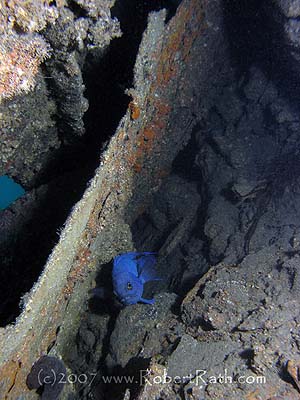 This Blue Devil, Paraplesiops meleagris seems quite at home here in the silty wreckage of the S.S. Clan Ranald. One of our most beautiful (if not one of our grumpiest looking) local inhabitants, the Blue Devil finds itself at home in caves, under deep ledges and of course in conveniently located shipwrecks.
It was one of those dives where the visibility was not really good enough for those classic panoramic wreck shots but I still wanted to capture the feel of the wreck. Photos inside nooks and crannies don't usually work out that well but this time I got lucky. Placing my camera down into a hole and around the corner I took this shot completely blind. I believe 'The Force' was strong in me that dive! 
Until the next post, take care out there and keep diving ( if that's what you do! ) ...Robert  Photo: Robert Rath C5060 1/30s at f/8.0 ISO100 Lens UWL100-28AD Inon D2000 Strobe
Photo: Robert Rath C5060 1/30s at f/8.0 ISO100 Lens UWL100-28AD Inon D2000 Strobe
Friday, April 27. 2007
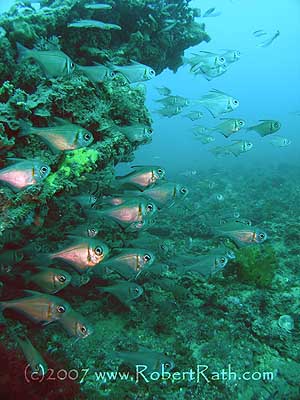 The Rough Bullseye, Pempheris klunzingeri. is endemic to all Australian temperate waters. Usually seen in caves or under ledges around inshore, rocky reefs to depths of around 20 m. The species is also known as Klunzinger's Bullseye.
This was such a picturesque image I had to capture it on a recent dive on the wreck of the Clan Ranald. At around 20m and in an area of strong tidal currents, 'The Clan' is a magnificent dive and well worth the effort to get to. Arguably South Australia's best historic wreck dive, the S.S Clan Ranald sank in 1909 with the loss of at least 36 lives. The site has been declared an historic shipwreck under the Historic Shipwrecks Act 1976 and is fully protected.
Until the next post, take care out there and keep diving ( if that's what you do! ) ...Robert 
Photo: Robert Rath C5060 1/45s at f/3.5 ISO100 Inon D2000 Strobe and Natural Light
Wednesday, April 18. 2007
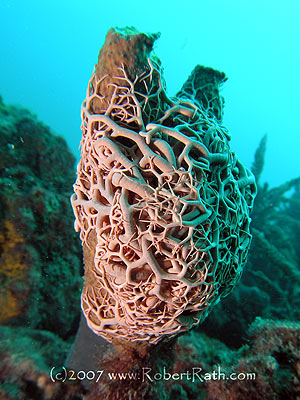 Erna's Basketstar, Astroboa ernae is one of the most amazing starfish you will ever meet. Found almost everywhere in Australian waters from temperate to tropical and down to around 50m.
Basketstars love reefy areas with strong currents so they can hang on while feeding. At rest, a star may be no bigger than a large fist but when out feeding may extend up to a metre across with arms outstretched and feeding tentacles extended.
This guy was a delightful treat to find at the end of a recent dive on the Troubridge Point reefs. Not far around the coast from Edithburgh, Troubridge Point offers a wonderful wild and rugged alternative to the usual cosy jetty dive!
Until the next post, take care out there and keep diving ( if that's what you do! ) ...Robert  Photo: Robert Rath C5060 1/45s at f/3.5 ISO100 Inon D2000 Strobe and Natural Light
Photo: Robert Rath C5060 1/45s at f/3.5 ISO100 Inon D2000 Strobe and Natural Light
Tuesday, April 10. 2007
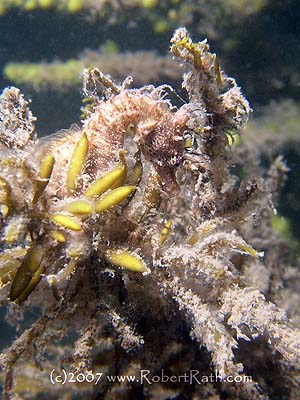 This photo taken last night should have been called "Master of Disguise" or "Guess What". Peering closely amid the algae and the silt you will see a Short-Head Seahorse, Hippocampus breviceps. This photo is an excellent example of how these little guys make themselves virtually invisible to both predators and photographers.
The Short-Head Seahorse is very common in the waters of southern Australia. They love areas that have good weedy habitat and can generally be found attached to seagrasses, sargassum weed and amongst the growth on jetty pylons. They can also be found in sponge gardens, especially on sponges in deeper water. They often occur in small groups and at night time they can be found congregating high on the weed to avoid predators. They are known to feed on small species such as mysids. They can be found from shallow water to at least 15 metres deep. They breed on a monthly cycle throughout summer and produce about 50 to 100 eggs in a brood. The Short-Head Seahorse grows to a maximum size of approximately 10cm.
Yes, as you guessed it we had a sensational Easter at Edithburgh with some great diving and great photos too, so stay tuned for more.
Until the next post, take care out there and keep diving ( if that's what you do! ) ...Robert  Photo: Robert Rath C5060 1/45s at f/6.7 ISO100 Inon D2000 Strobe
Photo: Robert Rath C5060 1/45s at f/6.7 ISO100 Inon D2000 Strobe
Monday, March 12. 2007
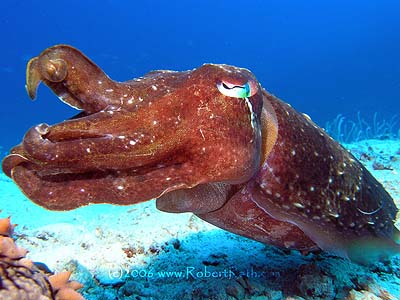 It's amazing the things you almost swim past without seeing!
We were at 20m and I spotted a sea cucumber down at 30m which demanded my photographic attention. No sooner had I positioned myself for a photo when an adjacent rock transformed into very put-out cuttlefish wanting to be photographed instead! Notice the orange lump in the bottom left of the picture, that's all the attention the sea cucumber got!
The Broadclub Cuttlefish, Sepia latimanus is the second largest cuttlefish species after our local Giant Cuttlefish Sepia apama, growing to 50 cm in mantle length. This guy is widely distributed in Northern Australian and Indo-Pacific waters and is the most common cuttlefish species on coral reefs. Please checkout CephBase for more information.
Also notice the sea grass in the background? Sea grass at 30m you ask? It turned out to be Garden Eels and yet another wonderful photo opportunity.
Until the next post, take care out there and keep diving ( if that's what you do! ) ...Robert  Photo: Robert Rath C5060 1/30s at f/4.8 ISO100 Inon D2000 Strobe
Photo: Robert Rath C5060 1/30s at f/4.8 ISO100 Inon D2000 Strobe
Saturday, March 10. 2007
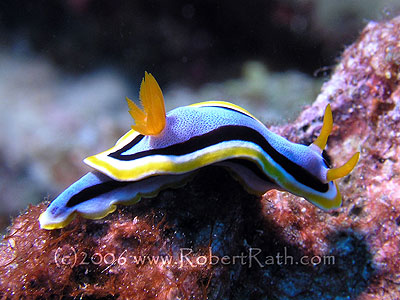 This absolutely stunning nudibranch Chromodoris annae was one of the photographic highlights of our trip last year to Milne Bay, PNG.
This little guy is often found on open rock walls and reef faces where it feeds on aplysilid sponges. This photo was taken on a section of deep exposed reef at about 20m.
A quick look around the Web will show that this is one of the most photgraphed of the tropical nudibranchs. Have a look at SeaSlug.info for more info.
Until the next post, take care out there and keep diving ( if that's what you do! ) ...Robert  Photo: Robert Rath C5060 1/45s at f/5.6 ISO100 Inon D2000 Strobe
Photo: Robert Rath C5060 1/45s at f/5.6 ISO100 Inon D2000 Strobe
Monday, February 12. 2007
 This Lined Dumpling Squid, also know as a Striped Pyjama Squid, Sepioloidea lineolata is all of about 5cm in length and a very cute inhabitant of my favourite dive site, Edithburgh.
There is some confusion of the distribution of this little guy ranging from a wide Southern Australian distribution through to local to Edithburgh only. I will keep an eye on this one and see where the consensus goes.
Until the next post, take care out there and keep diving ( if that's what you do! ) ...Robert  Photo: Robert Rath C5060 1/180s at f/3.5 ISO200 Natural Light
Photo: Robert Rath C5060 1/180s at f/3.5 ISO200 Natural Light
Saturday, February 3. 2007
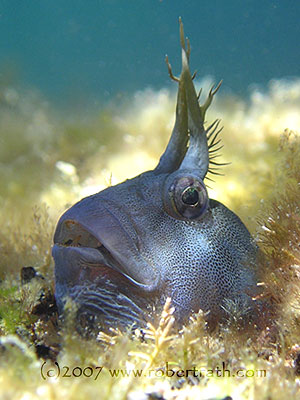 The Horned Blenny, Parablennius intermedius, is a wonderful little critter which abounds in reef, pylons and other structure all around Australia.
I had a rest day from diving today so a group of us just went snorkelling at Port Noarlunga with the snapshot camera. This cheeky little guy kept us entertained for quite some time as they are real posers!
I will be teaching again over the next couple of weeks so the camera will have to stay dry for a while. Don't worry though, I have plenty more photos to post.
Until the next post, take care out there and keep diving ( if that's what you do! ) ...Robert 
Tuesday, January 30. 2007
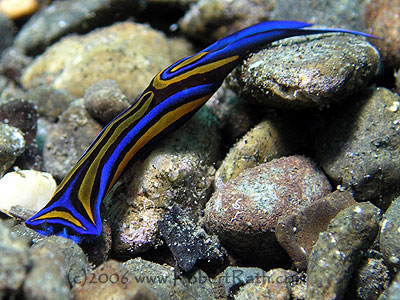 Jennifer spotted this Blue Swallowtail SeaSlug Chelidonura hirundinina all of about 20mm in length while diving off Luadi in PNG.
Closely related to Nudibranchs, this Opsithobranch lacks the characteristic cephalic tentacles and branchial plume of its close Gastropod relative. It is however every bit as stunning. Have a look at SeaSlug.net for more info.
Until the next post, take care out there and keep diving ( if that's what you do! ) ...Robert 
Friday, January 26. 2007
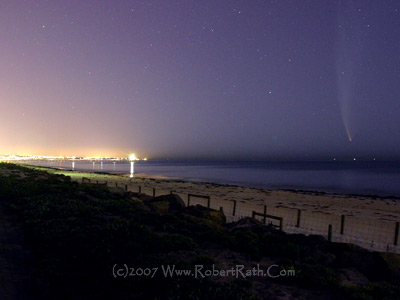 The comet is getting dimmer as it moves further and further from the Earth so only a few more photo opportunities to go.
This photo was taken tonight at our local beach at around 10:30pm and it shows the comet near the horizon looking back onto Henley Beach Jetty.
I promise to start posting more aquatic photos again soon.
... Robert 
Tuesday, January 23. 2007
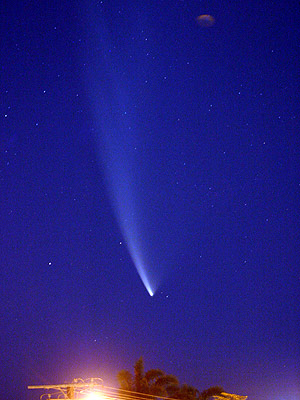 Well perhaps it is a little farther away than just above the roof, some 140 million kms or so and receding.
I took this photo from my roof top in suburban Adelaide so it really does not do the comet justice.
For really great photos have a look at NightSky Hunter (Mc Naught Gallery)
also try Astronomical Society of South Australia if you want to learn more about this awesome cosmic visitor.
...Robert 
Monday, January 1. 2007
 The Wordsworx website has finally gone LIVE.
...Robert 
Thursday, December 28. 2006
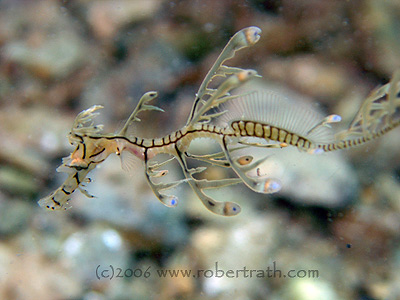 This week's photo, a juvenile (baby) Leafy Seadragon, Phycodurus eques, was taken yesterday under the jetty at Rapid Bay. Many thanks to my dive buddy Serdar for spotting this little guy. Very embarrassing, as I was supposed to be the dive guide.
I regularly take international guests on 'Leafy Tours'. Even though Rapid Bay is a 'sure bet' I still breathe a sigh of relief when we find our first one. The rest are a bonus. Thanks to Julius (South Africa), Rick (USA) and Serdar (Sweden) for a great day's diving. Looking forward to seeing you all back again.
Until the next post, take care out there and keep diving ( if that's what you do! ) ...Robert 
Tuesday, December 5. 2006
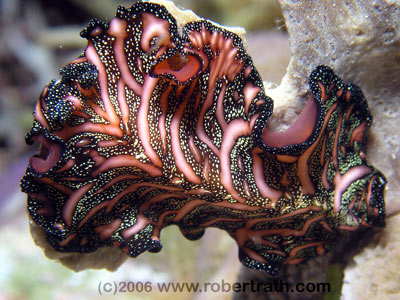 This week's photo, a Polyclad Flatworm, Pseudobiceros bedfordi, was taken during a recent trip to Milne Bay, Papua New Guinea. These beautiful worms are one of the most sought after creatures by both photographers and genetic biologists alike.
Not to be mistaken for nudibranchs, flatworms do not posses external gills. They are however just as diverse and beautiful and posses the astounding property of full regeneration.
Cut of any body part and a new creature will grow and the worm will repair itself. Cut it into ten and you will get ten new worms. In addition, Polyclad Flatworms are hermaphrodites possessing both male and female reproductive organs.
Here is an excellent website to find out much, much more about these amazing creatures Wolfgang Seifarth's Flatworm Site
Until the next post, take care out there and keep diving ( if that's what you do! ) ...Robert 
Wednesday, November 29. 2006
 The Inceptu website is getting a bit of life breathed back into it. The old discussion forum was a great idea at the time but without a bit of coaxing it did not really take off.
Enter 'The Blog'! I don't like the word but blogs have really hit it off as a medium for sharing with like minded communities. So welcome to the Inceptu blog.
I will regularly post articles, insights, thoughts, observations and general musing on creativity and innovation. Feel free to visit and subscribe (RSS) if you want to hear more.
...Robert 
|

 This stunning looking creature is also the prize of many great seafood chefs. The King Scallop, Pecten fumatus is highly prized by the commercial fishery industry in Southern Australia.
This stunning looking creature is also the prize of many great seafood chefs. The King Scallop, Pecten fumatus is highly prized by the commercial fishery industry in Southern Australia. This weekend's get-away took us to the Flinders Ranges in South Australia's mid-north.
This weekend's get-away took us to the Flinders Ranges in South Australia's mid-north.  I just love this sleepy little town with its world-famous jetty. Many times though, I find myself teaching a group of new divers when that magic photo opportunity literally swims on by...
I just love this sleepy little town with its world-famous jetty. Many times though, I find myself teaching a group of new divers when that magic photo opportunity literally swims on by... August 28, 2007 and we were treated to a most wonderful evening show. For around 45 minutes, the moon became red as it passed through the Earth's shadow.
August 28, 2007 and we were treated to a most wonderful evening show. For around 45 minutes, the moon became red as it passed through the Earth's shadow. The Potato Cod, Epinephelus tukula, is one of the largest members of the groper family. Cod Hole, out on the Northern Great Barrier Reef, is renowned for its family of curious Potato Cod who make this a special location for all who visit.
The Potato Cod, Epinephelus tukula, is one of the largest members of the groper family. Cod Hole, out on the Northern Great Barrier Reef, is renowned for its family of curious Potato Cod who make this a special location for all who visit. This Lionfish or Red Firefish, Pterois volitans, was a real poser circling the top of the Pinnacle. Yes, another cliché photo but one begging to be taken!
This Lionfish or Red Firefish, Pterois volitans, was a real poser circling the top of the Pinnacle. Yes, another cliché photo but one begging to be taken! This beautiful nudibranch, Chromodoris elisabethina, or possibly , Chromodoris annae, was one of several different species we found at Pixie Pinnacle during our Minke trip.
This beautiful nudibranch, Chromodoris elisabethina, or possibly , Chromodoris annae, was one of several different species we found at Pixie Pinnacle during our Minke trip. We have just returned from an absolutely wonderful trip to the Ribbon Reefs on the Great Barrier Reef. Three days of diving with Minke whales, reef fish, pelagics, sea turtles and even the odd diver have left us longing for the warm seas again now that we are back in Adelaide.
We have just returned from an absolutely wonderful trip to the Ribbon Reefs on the Great Barrier Reef. Three days of diving with Minke whales, reef fish, pelagics, sea turtles and even the odd diver have left us longing for the warm seas again now that we are back in Adelaide. I can't believe it has been nearly a month since my last post! This last weekend we were in Edithburgh again with a group of nine Open Water students. Even with 11 degrees, wetsuits and less than 2m visibility, they were a fantastic and enthusiastic group. Well done!
I can't believe it has been nearly a month since my last post! This last weekend we were in Edithburgh again with a group of nine Open Water students. Even with 11 degrees, wetsuits and less than 2m visibility, they were a fantastic and enthusiastic group. Well done! Night dives under Edithburgh jetty mean seahorses. Lots and lots of them! Almost all of them will be the Short-Head Seahorse, Hippocampus breviceps. No matter how patient I was, this little one would not look at me, so this is the best of a batch where turning away means 'you can't see me'.
Night dives under Edithburgh jetty mean seahorses. Lots and lots of them! Almost all of them will be the Short-Head Seahorse, Hippocampus breviceps. No matter how patient I was, this little one would not look at me, so this is the best of a batch where turning away means 'you can't see me'. Every once in a while someone very special comes along who reminds us how wonderful our world is and how dreams really do come true when you desire and believe. Little 13-year-old Rachael from California is someone who came into my world and did just that.
Every once in a while someone very special comes along who reminds us how wonderful our world is and how dreams really do come true when you desire and believe. Little 13-year-old Rachael from California is someone who came into my world and did just that. This week's photo is relic from the archives, my very first photograph of a Leafy Seadragon, Phycodurus eques.
This week's photo is relic from the archives, my very first photograph of a Leafy Seadragon, Phycodurus eques. Ok, nothing to do with diving but something to make your life more enjoyable all the same.
Ok, nothing to do with diving but something to make your life more enjoyable all the same. Well it seems that unless you can eat it no one bothers to give anything a common name so Ceratosoma amoena will have to do.
Well it seems that unless you can eat it no one bothers to give anything a common name so Ceratosoma amoena will have to do. This Blue Devil, Paraplesiops meleagris seems quite at home here in the silty wreckage of the S.S. Clan Ranald. One of our most beautiful (if not one of our grumpiest looking) local inhabitants, the Blue Devil finds itself at home in caves, under deep ledges and of course in conveniently located shipwrecks.
This Blue Devil, Paraplesiops meleagris seems quite at home here in the silty wreckage of the S.S. Clan Ranald. One of our most beautiful (if not one of our grumpiest looking) local inhabitants, the Blue Devil finds itself at home in caves, under deep ledges and of course in conveniently located shipwrecks. The Rough Bullseye, Pempheris klunzingeri. is endemic to all Australian temperate waters. Usually seen in caves or under ledges around inshore, rocky reefs to depths of around 20 m. The species is also known as Klunzinger's Bullseye.
The Rough Bullseye, Pempheris klunzingeri. is endemic to all Australian temperate waters. Usually seen in caves or under ledges around inshore, rocky reefs to depths of around 20 m. The species is also known as Klunzinger's Bullseye. Erna's Basketstar, Astroboa ernae is one of the most amazing starfish you will ever meet. Found almost everywhere in Australian waters from temperate to tropical and down to around 50m.
Erna's Basketstar, Astroboa ernae is one of the most amazing starfish you will ever meet. Found almost everywhere in Australian waters from temperate to tropical and down to around 50m. This photo taken last night should have been called "Master of Disguise" or "Guess What". Peering closely amid the algae and the silt you will see a Short-Head Seahorse, Hippocampus breviceps. This photo is an excellent example of how these little guys make themselves virtually invisible to both predators and photographers.
This photo taken last night should have been called "Master of Disguise" or "Guess What". Peering closely amid the algae and the silt you will see a Short-Head Seahorse, Hippocampus breviceps. This photo is an excellent example of how these little guys make themselves virtually invisible to both predators and photographers. It's amazing the things you almost swim past without seeing!
It's amazing the things you almost swim past without seeing! This absolutely stunning nudibranch Chromodoris annae was one of the photographic highlights of our trip last year to Milne Bay, PNG.
This absolutely stunning nudibranch Chromodoris annae was one of the photographic highlights of our trip last year to Milne Bay, PNG. This Lined Dumpling Squid, also know as a Striped Pyjama Squid, Sepioloidea lineolata is all of about 5cm in length and a very cute inhabitant of my favourite dive site, Edithburgh.
This Lined Dumpling Squid, also know as a Striped Pyjama Squid, Sepioloidea lineolata is all of about 5cm in length and a very cute inhabitant of my favourite dive site, Edithburgh. The Horned Blenny, Parablennius intermedius, is a wonderful little critter which abounds in reef, pylons and other structure all around Australia.
The Horned Blenny, Parablennius intermedius, is a wonderful little critter which abounds in reef, pylons and other structure all around Australia. Jennifer spotted this Blue Swallowtail SeaSlug Chelidonura hirundinina all of about 20mm in length while diving off Luadi in PNG.
Jennifer spotted this Blue Swallowtail SeaSlug Chelidonura hirundinina all of about 20mm in length while diving off Luadi in PNG.  The comet is getting dimmer as it moves further and further from the Earth so only a few more photo opportunities to go.
The comet is getting dimmer as it moves further and further from the Earth so only a few more photo opportunities to go. Well perhaps it is a little farther away than just above the roof, some 140 million kms or so and receding.
Well perhaps it is a little farther away than just above the roof, some 140 million kms or so and receding.
 This week's photo, a juvenile (baby) Leafy Seadragon, Phycodurus eques, was taken yesterday under the jetty at Rapid Bay. Many thanks to my dive buddy Serdar for spotting this little guy. Very embarrassing, as I was supposed to be the dive guide.
This week's photo, a juvenile (baby) Leafy Seadragon, Phycodurus eques, was taken yesterday under the jetty at Rapid Bay. Many thanks to my dive buddy Serdar for spotting this little guy. Very embarrassing, as I was supposed to be the dive guide.  This week's photo, a Polyclad Flatworm, Pseudobiceros bedfordi, was taken during a recent trip to Milne Bay, Papua New Guinea. These beautiful worms are one of the most sought after creatures by both photographers and genetic biologists alike.
This week's photo, a Polyclad Flatworm, Pseudobiceros bedfordi, was taken during a recent trip to Milne Bay, Papua New Guinea. These beautiful worms are one of the most sought after creatures by both photographers and genetic biologists alike.


